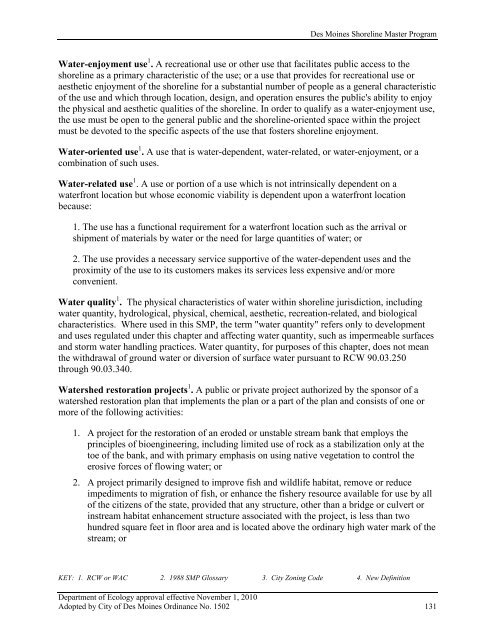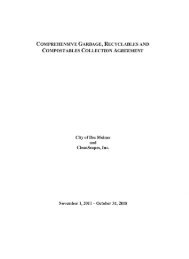CITY OF DES MOINES SHORELINE MASTER PROGRAM
CITY OF DES MOINES SHORELINE MASTER PROGRAM
CITY OF DES MOINES SHORELINE MASTER PROGRAM
Create successful ePaper yourself
Turn your PDF publications into a flip-book with our unique Google optimized e-Paper software.
Des Moines Shoreline Master Program<br />
Water-enjoyment use 1 . A recreational use or other use that facilitates public access to the<br />
shoreline as a primary characteristic of the use; or a use that provides for recreational use or<br />
aesthetic enjoyment of the shoreline for a substantial number of people as a general characteristic<br />
of the use and which through location, design, and operation ensures the public's ability to enjoy<br />
the physical and aesthetic qualities of the shoreline. In order to qualify as a water-enjoyment use,<br />
the use must be open to the general public and the shoreline-oriented space within the project<br />
must be devoted to the specific aspects of the use that fosters shoreline enjoyment.<br />
Water-oriented use 1 . A use that is water-dependent, water-related, or water-enjoyment, or a<br />
combination of such uses.<br />
Water-related use 1 . A use or portion of a use which is not intrinsically dependent on a<br />
waterfront location but whose economic viability is dependent upon a waterfront location<br />
because:<br />
1. The use has a functional requirement for a waterfront location such as the arrival or<br />
shipment of materials by water or the need for large quantities of water; or<br />
2. The use provides a necessary service supportive of the water-dependent uses and the<br />
proximity of the use to its customers makes its services less expensive and/or more<br />
convenient.<br />
Water quality 1 . The physical characteristics of water within shoreline jurisdiction, including<br />
water quantity, hydrological, physical, chemical, aesthetic, recreation-related, and biological<br />
characteristics. Where used in this SMP, the term "water quantity" refers only to development<br />
and uses regulated under this chapter and affecting water quantity, such as impermeable surfaces<br />
and storm water handling practices. Water quantity, for purposes of this chapter, does not mean<br />
the withdrawal of ground water or diversion of surface water pursuant to RCW 90.03.250<br />
through 90.03.340.<br />
Watershed restoration projects 1 . A public or private project authorized by the sponsor of a<br />
watershed restoration plan that implements the plan or a part of the plan and consists of one or<br />
more of the following activities:<br />
1. A project for the restoration of an eroded or unstable stream bank that employs the<br />
principles of bioengineering, including limited use of rock as a stabilization only at the<br />
toe of the bank, and with primary emphasis on using native vegetation to control the<br />
erosive forces of flowing water; or<br />
2. A project primarily designed to improve fish and wildlife habitat, remove or reduce<br />
impediments to migration of fish, or enhance the fishery resource available for use by all<br />
of the citizens of the state, provided that any structure, other than a bridge or culvert or<br />
instream habitat enhancement structure associated with the project, is less than two<br />
hundred square feet in floor area and is located above the ordinary high water mark of the<br />
stream; or<br />
KEY: 1. RCW or WAC 2. 1988 SMP Glossary 3. City Zoning Code 4. New Definition<br />
Department of Ecology approval effective November 1, 2010<br />
Adopted by City of Des Moines Ordinance No. 1502 131



